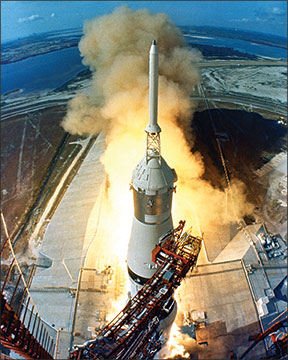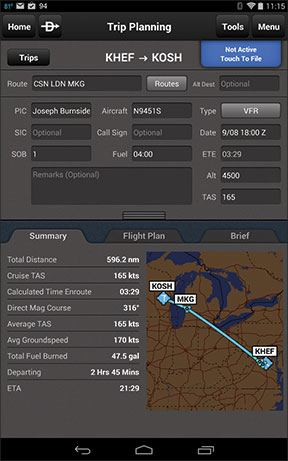Over the past several years, the FAA and industry have promoted establishing and adhering to personal minimums as a way to manage the risk inherent in personal aviation. These are viewed as self-imposed limitations based upon personal experience, training and certification, equipment or other factors. Some people grumbled and others enthusiastically embraced the concept. Your reaction, as well as mine, depends on how you and I approach the subject. One way to look at personal minimums is to think of them as creating margins separating us from greater risk.

An example can be found on this page: On both sides, and at the top and bottom, there’s some white space, delineating where and how this article and its artwork will be placed. Much of the concept behind margins on a printed page is one of style, but the closer the article’s text gets to the edge of the paper, the harder it can be to read. You, the reader, will get distracted by the edges, and the page won’t be appealing to look at or read. All forms of aviation are similar—the closer we get to certain margins, the more difficult things can be.
With Dispatch
“Margin” is an interesting word. One definition is as “a border or edge or a limit.” A more interesting defnition is “a provision for increase and beyond what is needed.” So, margins help to keep things in their place but also can be planned opportunities.
My introduction to margins in commercial aviation came while attending dispatcher’s school. Many commercial operations and all Part 121 carriers are based on some type of dispatching system. Dispatching consists of flight, fuel and load planning, as well as monitoring the flight after departure. In Part 121 operations, the dispatcher serves as something of a co-captain, sharing responsibility with the PIC for the safe outcome of each flight. Being removed from the immediate flight deck action allows a dispatcher to look ahead at contingencies that might occur as well as plan for success. This isn’t something a dispatcher does in a vacuum. Instead, its accomplished with specific guidance to help build margins around the proposed operation.
Op Specs
Airlines operating under Part 121 have operations specifications (Op Specs), which describes how the company operates. It’s a single document developed through Part 119 of the FARs by the operator in conjunction with the FAA and governs all things for the airline.
Among other things, it contains all authorizations, limits and procedures used by the carrier. Some of these include authorized aircraft and airports, operations such as ETOPS, and authorized deviations from other parts of the FARs. Some of the regulatory deviations covered by the Op Specs include exemptions for takeoffs, visibility required, fuel planning and the approach at an alternate. Other exemptions are made for the selection of alternate airport weather minimums. Although at first glance it may seem a carrier’s Op Specs are a limiting factor, careful examination demonstrates they really are a series of margins incorporating provisions for increased flexibility.
As an example, when planning to divert a flight to an alternate airport, the Op Spec designers consider many “what-if” questions. Factors considered can include traffic issues while en route to the alternate, the possibility of holding and whether a missed approach at the alternate is likely. That’s one reason the selection of an alternate and the weather minimums required rank high in the authorized deviations from the FARs provided by Op Specs.
Minimum Math
As an example, let’s look at the requirements for selecting an alternate airport when one is necessary. You may be familiar with the basic IFR alternate minimums found in FAR 91.169(c): ceiling of 600 feet and one sm visibility for precision approaches and 800 feet and one sm for all others. (It’s important to note that, in the U.S., ceiling is not a controlling minimum for a destination, only visibility. For alternate airports the minimums are always a ceiling/visibility combination). Those are straightforward, well-understood requirements. However, a carrier’s Op Specs may allow for something a little different: derived minimums.
Derived minimums are not a given standard. Rather they are computed from all the available approaches at the alternate airport and fluctuate depending upon the approaches available. Basically a value is added to the approach minimums found on the approach chart. These values are determined by either a one- or two-navaid rule.
The one-navaid rule is based upon either the alternate airport having only one IAP, or the dispatcher choosing to use only one approach. It’s required that the navaids used for the approach must be monitored, so Notams must be checked. Performance limits such as tailwind components cannot be exceeded. If the approach passes muster, then the chart is consulted.
The decision height (DH) on the procedure is rounded up to the next hundred feet (e.g., if the published DH is 402 feet, you must begin with 500 feet for your calculation). Then another 400 feet always is added to the increased DH of each approach. Next, a mile is added to the published visibility. So if your published IAP presents a DH of 402 feet and visibility ¾ sm, your alternate minimums in this case would be 900 feet and 1¾ sm. Using the one-navaid rule, the lowest possible alternate minimums would a 600-foot ceiling and 1½ sm visibility.
The two-navaid rule provides more flexibility and the opportunity to get lower minimums, but it’s a bit more complex. It compares all available approaches and uses the highest minimums of the lowest two approaches (I was confused the first time, too!). It goes something like this: First, the approaches must be to different runways and use different navaids. Two different RNAV approaches cannot be used in determining the calculations. Also, circling minimums cannot be used.
You take the remaining eligible approaches and choose the two with the lowest minimums. Of these, you choose the one with the higher DH. Then round up the DH to the next-highest 100-foot value as was done in the one-navaid rule. Finally, add 200 feet for your ceiling value.
Next you take the two visibilities and choose the higher of the two. To that number you add ½ sm. Yes, it is possible, and usually routine, to pick a ceiling value from one of the two approaches and the visibility from the other. The result in using the two-navaid rule is the possibility of having alternate minimums as low as 400 feet and one sm.
What all this means is that the airline is not constrained by a one-size-fits-all attitude when it comes to flight planning, departures or alternate arrivals. Rather, it has the ability to realistically look at mission requirements and build individual margins from the beginning. The beauty of Op Specs for the FAR 121 operator is that they are provided with more flexibility in their operations. At the same time, it allows specific guidance which allows them almost assured mission success. Rather than being a restraint, they are able to have enough of a margin to cover almost any contingency. What does this mean for us?
Accurate Flight Planning?
We live in an amazing electronic flight planning age. Slick apps on our smartphones and Web-based services have replaced whiz wheels, charts and calculators for most, if not all, flight-planning tasks. Even the simplest of these flight-planning tools will accurately determine your arrival time and compute your fuel burn—my experience is that the results usually are within a single minute of the actual time flown. The software also will compute fuel burned during the missed approach, plus the exact time and fuel to the alternate. We only need to add the 45-minute reserve for the total fuel required.
Is that enough? Have we built a margin for the approach to the destination, traffic and vectoring, the missed approach, as well as the approach to the alternate into that figure? If we have a set standard for these margins (say, 30 minutes) we can automatically add this to the total fuel planning figure each time. The sidebar on the opposite page explores this question in greater detail.
What about margins for approach minimums to the destination as well as the alternate? We see that the Part 121 folks have a formula for alternates that “floats” based on the charted figures. Perhaps, rather than having an absolute fixed personal minimum from the top down (e.g., ceiling 1000 feet and visibility one statute mile), we add a fixed value to each approach, say 200 feet and an additional ¼ mile, added from the “bottom up.”
Right-Side Up
I wonder if many of us have been looking at this the wrong way. As discussed, we have been using margins as an upper limit on our planning. Perhaps we should be looking at margins from the bottom up, and building opportunities into our flight planning system like the airlines use. Like the rocket scientists at NASA, they are asking the important questions about what is needed or could happen in the future. They are building margins to make the mission flexible. Are we?
We can either have true margins to make our mission a success, or else consider ourselves just marginalized. It’s all in how you look at it.
Saturn V
The importance of margins in aviation and aerospace was not lost on the many who observed the U.S. space program in its formative years. Despite numerous early setbacks and the pressures of playing catch-up to the Soviet Union, small rockets and launch vehicles gave way to larger ones, capable of lifting greater and greater payloads to orbit.

Eventually, the Saturn V rocket was developed as a heavy-lift vehicle and was the one used for all Apollo launches, including those destined only for earth orbit. Successive iterations of the Saturn V placed ever-heavier payloads in orbit.
The Saturn V generated greater peak thrust than the subsequent Space Shuttle. To date, no other launch vehicle, including the Shuttle, has exceeded the Saturn V in weight or payload. All Saturn V launches were successful: Their payloads were placed in orbit.
One reason the Saturn V was so successful involved engineering into it the ability to expand its mission and capabilities. An example involved planning for failure: If one of the Saturn V’s first-stage rocket engines failed to produce expected thrust, the others were burned longer to compensate.
ince many of the contractors working on the Saturn and Apollo programs also happened to be heavily involved in the commercial aviation industry, it didn’t take long for companies like Boeing, Douglas, Rockwell International and Pratt and Whitney to adopt the same concepts behind the Saturn V’s scalability for their own products.
Flight-Planning Margins

There’s no question the recent proliferation of smartphone- and tablet-based flight-planning tools has improved the accuracy of information we use to make the go/no-go decision. All we have to do is input our departure point and destination, along with our desired altitude, proposed takeoff time and en route fixes, if any. The results are as good as they can be, given the information provided. But those results fail to consider certain variables.
A good example involves projected fuel burn. The screenshot at right depicts a proposed VFR flight from the Manassas (Va.) Regional Airport/Harry P. Davis Field (KHEF) to Wittman Regional Airport (KOSH) in Oshkosh, Wis. Note the estimated time en route and the fuel on-board values, which are circled in yellow.
Is 31 minutes enough of a fuel reserve? The FARs say so, and everyone knows computers don’t make mistakes, right? So, I can confidently launch as planned, knowing we’ll both be legal and safe, right? Not necessarily.
Putting aside the wisdom of crossing Lake Michigan at 4500 feet msl in a single, what if I sit idling in the run-up area at KHEF for a few extra minutes while ATC works with a gaggle of arrivals? What if the en route winds aloft are a couple of knots stronger than forecast? In both instances, I’ll eat into my reserve fuel, that’s what. What if the preceding airplane lands gear-up at KOSH while I’m on short final? I’ll have to go around, won’t I?
Here’s the problem: Many flight-planning applications simply presume the projected fuel burn will be the same for each hour of the flight. In fact, we’ll always burn more fuel during the first hour than each successive one because we take off and climb at higher power settings than we use for cruising. In my airplane, that means I’m burning some 28-29 gph during takeoff and initial climb, but only 12-13 gph during cruise. As one result, I input 18 gph for the first hour, then 13 gph for the rest of the flight.
If I have to go around upon arriving at KOSH, I’m going to be burning the 28-29 gph of a full-power takeoff and climb, not the measly 13 or fewer I expected for this portion of the flight. And we haven’t even gotten into the possibility of mishandling the leaning process, en route full-power climbs or failing to properly estimate the available fuel. Yes, in the event of a go-around at KOSH, I won’t be at full power for very long, but I’m definitely not going to land with a full 30 minutes in the tanks.
Depending on what you’ve entered into your flight-planning application for hourly fuel burn, you could be just fine and legal. But perhaps not. In this instance, expanding your margins means an understanding of your flight-planning app’s limitations, along with a healthy dose of reality. — J.B.




